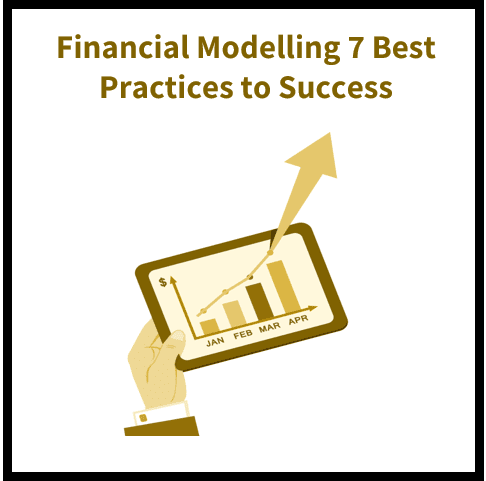With the ever-changing financial world and the growing complexity of tax regulations, accounting standards, and reporting requirements, it is no surprise that professionals need to become more competent and effective in their day-to-day practices. Whether you are a student in your first accounting program, a seasoned professional seeking to advance your career, or an experienced accountant looking to sharpen your skills, there are many ways to become a better accountant.
Accounting is a discipline that requires a strong logical mind, attention to detail, accuracy, and an understanding of financial statements, accounting principles, and accounting models. To accomplish this, you need to learn the best practices in financial modeling.
Read on to discover the top 7 steps to success in financial modeling.
Think Like an Investor
As a financial modeler, your first step is to think like an investor. What does an investor want to know about a business? This is the key question you need to ask yourself. The specific metrics you show will depend on what information the investor is looking for.
When investors look at financial statements, they want to see a clear picture of the business’s financial health. Some of the key metrics that investors look at include a company’s:
- Profitability – Are they making money?
- Liquidity – Can they pay their debts?
- Solvency – Are they a good bet for creditors?
- Growth – Does the business have the potential to grow?
- Expansion – Are they investing in the future?
Define Key Terms
When you begin to learn advanced financial modeling concepts, it can be helpful to first define key terms. This will make it easier to follow along in your accounting textbooks and online accounting courses.
When you start to model more complex scenarios, it is important that you are up to speed on the terminology and concepts used in the models. If you don’t know the correct terms, you may create inaccurate models that do not reflect reality.
Here are a few terms you may run into when modeling financial scenarios:
- Cash flow – The amount of money that is coming into or going out of a business during a specific time period.
- NPV – A cash flow analysis acronym that stands for Net Present Value. It shows the best cash flow amount that could be received at any time in the future. Sometimes cash flows are presented as “discounted cash flows.”
- CFIT – Cash Flow from Interest on Debt.
- ROE – Return on Equity.
- IRR – The Internal Rate of Return.
- MIRR – The Modified Internal Rate of Return.
Prepare the Financial Statements
Once you have modeled the key metrics, you are ready to prepare the financial statements. There are a variety of financial modeling techniques, including piecing together financial statements, financial analysis, ratio analysis, graphic modeling, and scenario analysis.
The most important step while modeling is to be accurate. By being careful with the steps you take, you can keep your models as accurate as possible. If there is anything that is not correct, it will affect the results.
Complete the Cash Flow
Cash flow is the amount of money that a business generates through its normal activities. You will usually start most financial modeling exercises by completing the cash flow section of a company’s financial statements.
This will give you an idea of how much money a company has coming in and going out during a specific time period. You will also need to know what is invested, what is being paid back to creditors, and what is being held as inventory.
Incorporate New Information
One of the best parts about financial modeling is that it can be used to incorporate new information, such as a new deal or an investment from a large company.
The process of incorporating information is simple. You simply model the new information and then compare the results to the original financial model.
Once you have completed this step, you are ready for the next step.
Summarize Key Results
The final step in modeling a financial scenario is to summarize key results. This will help you to clearly communicate the business’s financial health. For example, you may want to create a table that shows the cash flow generated by the business, the amount of money invested, and the amount of money that is owed to creditors.
You may also want to create a graph that clearly illustrates the results of the business.
Develop a thorough understanding of the company
The most effective way to become a better accountant is to learn all you can about the business you are modeling.
Start by looking at the company’s financial statements.
Explore the business’s history, what their products or services are, and their competitors.
By doing this, you will have a better idea of what you are modeling. You will also have a clearer sense of what is important to know about the company.
By gaining a better understanding of the business, you will have a better sense of what their financial health is like and what their prospects are for the future.
Define the key metrics you’ll be using
Once you have completed the financial modeling process, you will want to decide on the key metrics you will be using. This is important because each metric will have different meanings to different people.
You want to choose the metrics that are easy to understand, provide a clear picture of the company’s financial health, and are relevant to the industry.
You may also want to create a business plan that summarizes your financial modeling process and the key metrics you will be using. This will help to clearly communicate the results and help your boss or investors understand the model.
List the assumptions and risks involved
Once you have completed the financial modeling process, you will want to look at each metric you are using and identify the assumptions and risks involved. You want to clearly identify any factors that may change the results, such as:
- Growth – Is the business investing in the future?
- Profitability – Are they making money?
- IRR – Is the model reliable?
- Relative Strength – Is the model reliable?
- Cash Conversion Cycle – Is the business competitive in their industry?
- CFIT – Is the model reliable?
Conclusion
The key to becoming a better accountant is to constantly learn new techniques, improve your skills, and reflect on your work to find ways to be a better accountant.
Financial modeling is a great way to sharpen your skills and connect to the financial world. By using advanced modeling techniques, you can model a variety of scenarios and see how they would affect a company’s financial health.
While it can be challenging to learn new techniques and stay up to date on regulations and best practices, it is important to remember that this is a discipline that requires a strong logical mind, attention to detail, accuracy, and an understanding of financial statements, accounting principles, and accounting models.
To accomplish this, you need to learn the best practices in financial modeling.




26 thoughts on “Financial Modelling Best Practices: The 7 Steps to Success””
… [Trackback]
[…] Read More to that Topic: skillfine.com/financial-modelling-best-practices/ […]
… [Trackback]
[…] Read More on that Topic: skillfine.com/financial-modelling-best-practices/ […]
… [Trackback]
[…] Info to that Topic: skillfine.com/financial-modelling-best-practices/ […]
… [Trackback]
[…] Read More to that Topic: skillfine.com/financial-modelling-best-practices/ […]
… [Trackback]
[…] Find More on on that Topic: skillfine.com/financial-modelling-best-practices/ […]
… [Trackback]
[…] There you will find 71456 more Info on that Topic: skillfine.com/financial-modelling-best-practices/ […]
… [Trackback]
[…] Here you can find 19664 additional Info on that Topic: skillfine.com/financial-modelling-best-practices/ […]
… [Trackback]
[…] Info on that Topic: skillfine.com/financial-modelling-best-practices/ […]
… [Trackback]
[…] Read More here on that Topic: skillfine.com/financial-modelling-best-practices/ […]
… [Trackback]
[…] There you will find 68325 additional Information on that Topic: skillfine.com/financial-modelling-best-practices/ […]
… [Trackback]
[…] Find More Information here to that Topic: skillfine.com/financial-modelling-best-practices/ […]
… [Trackback]
[…] Information to that Topic: skillfine.com/financial-modelling-best-practices/ […]
… [Trackback]
[…] Find More to that Topic: skillfine.com/financial-modelling-best-practices/ […]
… [Trackback]
[…] There you can find 13727 more Info to that Topic: skillfine.com/financial-modelling-best-practices/ […]
… [Trackback]
[…] Read More on on that Topic: skillfine.com/financial-modelling-best-practices/ […]
… [Trackback]
[…] Find More to that Topic: skillfine.com/financial-modelling-best-practices/ […]
… [Trackback]
[…] Here you can find 26765 more Info to that Topic: skillfine.com/financial-modelling-best-practices/ […]
… [Trackback]
[…] Info to that Topic: skillfine.com/financial-modelling-best-practices/ […]
… [Trackback]
[…] Read More to that Topic: skillfine.com/financial-modelling-best-practices/ […]
Your article made me suddenly realize that I am writing a thesis on gate.io. After reading your article, I have a different way of thinking, thank you. However, I still have some doubts, can you help me? Thanks.
Explore and discuss the values that individuals hold dear. How do these values shape their decisions, actions, and overall outlook on life?
Can you be more specific about the content of your article? After reading it, I still have some doubts. Hope you can help me.
Thanks for sharing. I read many of your blog posts, cool, your blog is very good.
I’m often to blogging and i really appreciate your content. The article has actually peaks my interest. I’m going to bookmark your web site and maintain checking for brand spanking new information.
464975 350625I just couldnt depart your website prior to suggesting that I very enjoyed the standard information an individual offer for your visitors? Is gonna be back regularly in order to inspect new posts 199182
Thanks for sharing. I read many of your blog posts, cool, your blog is very good.